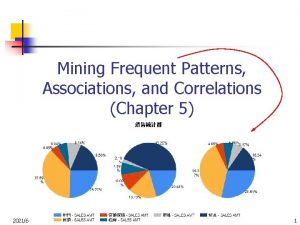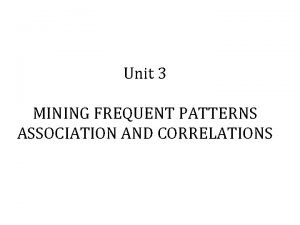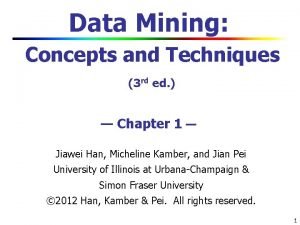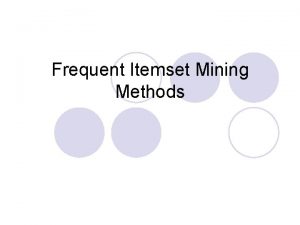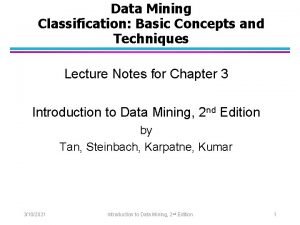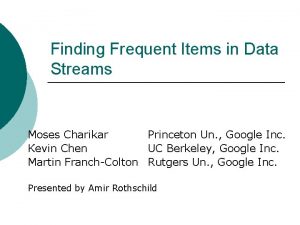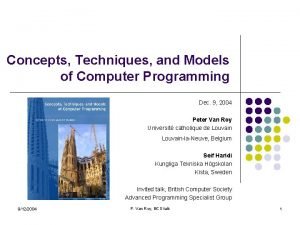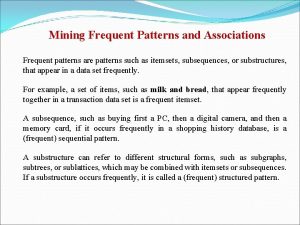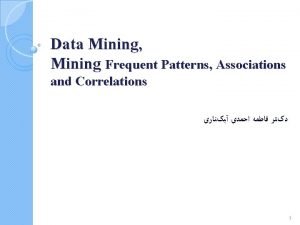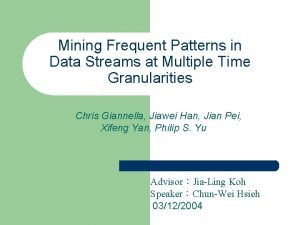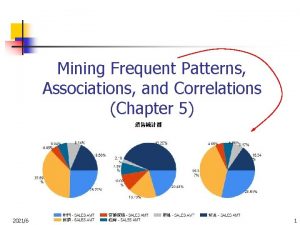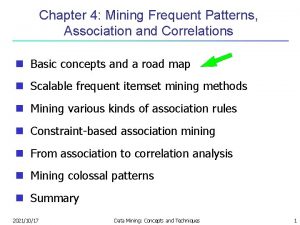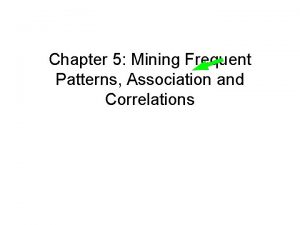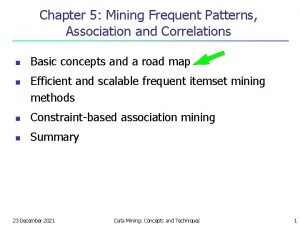Data Mining Concepts and Techniques Mining Frequent Patterns












































- Slides: 44

Data Mining: Concepts and Techniques Mining Frequent Patterns & Association Rules Dr. Maher Abuhamdeh

What Is Frequent Pattern Analysis? • Frequent pattern: a pattern (a set of items, subsequences, substructures, etc. ) that occurs frequently in a data set • First proposed by Agrawal, Imielinski, and Swami [AIS 93] in the context of frequent itemsets and association rule mining • Motivation: Finding inherent regularities in data – What products were often purchased together? — Tea and Milk? ! – What are the subsequent purchases after buying a PC? – What kinds of DNA are sensitive to this new drug? – Can we automatically classify web documents? • Applications – Basket data analysis, cross-marketing, catalog design, sale campaign analysis, .

Applications • Market Basket Analysis: given a database of customer transactions, where each transaction is a set of items the goal is to find groups of items which are frequently purchased together. • Telecommunication (each customer is a transaction containing the set of phone calls) • Credit Cards/ Banking Services (each card/account is a transaction containing the set of customer’s payments) • Medical Treatments (each patient is represented as a transaction containing the ordered set of diseases) • Basketball-Game Analysis (each game is represented as a transaction containing the ordered set of ball passes)

Basic Concepts: Frequent Patterns Tid Items bought 10 Tea, Nuts, Diaper 20 Tea, Coffee, Diaper 30 Tea, Diaper, Eggs 40 Nuts, Eggs, Milk 50 Nuts, Coffee, Diaper, Eggs, Milk Customer buys both Customer buys Tea Customer buys diaper • itemset: A set of one or more items • k-itemset X = {x 1, …, xk} • (absolute) support, or, support count of X: Frequency or occurrence of an itemset X • (relative) support, s, is the fraction of transactions that contains X (i. e. , the probability that a transaction contains X) • An itemset X is frequent if X’s support is no less than a minsup threshold

Basic Concepts: Association Rules Tid 10 20 30 40 50 Items bought Tea, Nuts, Diaper Tea, Coffee, Diaper Tea, Diaper, Eggs Nuts, Eggs, Milk Nuts, Coffee, Diaper, Eggs, Milk Customer buys both Customer buys Tea Customer buys diaper • Find all the rules X Y with minimum support and confidence – support, s, probability that a transaction contains X Y – confidence, c, conditional probability that a transaction having X also contains Y Let minsup = 50%, minconf = 50% Freq. Pat. : Tea: 3, Nuts: 3, Diaper: 4, Eggs: 3, {Tea, Diaper}: 3

Rule Measures: Support & Confidence • Simple Formulas: – Confidence (A B) = #tuples containing both A & B / #tuples containing A = P(B|A) = P(A U B ) / P (A) – Support (A B) = #tuples containing both A & B/ total number of tuples = P(A U B) • What do they actually mean ? Find all the rules X & Y Z with minimum confidence and support – support, s, probability that a transaction contains {X, Y, Z} – confidence, c, conditional probability that a transaction having {X, Y} also contains Z



Support & Confidence : An Example Let minimum support 50%, and minimum confidence 50%, then we have, – A C (50%, 66. 6%) – C A (50%, 100%)

FP Growth (Han, Pei, Yin 2000) • One problematic aspect of the Apriori is the candidate generation – Source of exponential growth • Another approach is to use a divide and conquer strategy • Idea: Compress the database into a frequent pattern tree representing frequent items

FP Growth (Tree construction) • Initially, scan database for frequent 1 -itemsets – Place resulting set in a list L in descending order by frequency (support) • Construct an FP-tree – Create a root node labeled null – Scan database • Process the items in each transaction in L order • From the root, add nodes in the order in which items appear in the transactions • Link nodes representing items along different branches

FP-Tree Algorithm -- Simple Case Transaction_id Time Items_bought 101 6: 35 Milk, bread, cookies, juice 792 7: 38 Milk, juice 1130 8: 05 Milk, eggs 1735 8: 40 Bread, cookies, coffee

FP Growth – Another Example TID Items 1 I 1, I 2, I 5 2 I 2, I 4 3 I 2, I 3, I 6 4 I 1, I 2, I 4 5 I 1, I 3 6 I 2, I 3 7 I 1, I 3 8 I 1, I 2, I 3, I 5 9 I 1, I 2, I 3 • Minimum support of 20% (frequency of 2) • Frequent 1 -itemsets I 1, I 2, I 3, I 4, I 5 • Construct list L = {(I 2, 7), (I 1, 6), (I 3, 6), (I 4, 2), (I 5, 2)}

Build FP-Tree Create root node I 2 1 I 1 1 I 3 0 I 4 0 I 5 1 null (I 2, 1) (I 1, 1) (I 5, 1) Scan database Transaction 1: I 1, I 2, I 5 Order: I 2, I 1, I 5 Process transaction Add nodes in item order Label with items, count Maintain header table

Build FP-Tree I 2 2 I 1 1 I 3 0 I 4 1 I 5 1 null (I 2, 2) (I 1, 1) (I 5, 1) (I 4, 1) TID Items 1 I 1, I 2, I 5 2 I 2, I 4 3 I 2, I 3, I 6 4 I 1, I 2, I 4 5 I 1, I 3 6 I 2, I 3 7 I 1, I 3 8 I 1, I 2, I 3, I 5 9 I 1, I 2, I 3

Minining the FP-tree • Start at the last item in the table • Find all paths containing item – Follow the node-links • Identify conditional patterns – Patterns in paths with required frequency • Build conditional FP-tree C • Append item to all paths in C, generating frequent patterns • Mine C recursively (appending item) • Remove item from table and tree

Mining the FP-Tree I 2 7 I 1 6 I 3 6 I 4 2 I 5 null (I 1, 2) (I 2, 7) (I 1, 4) 2 (I 5, 1) (I 3, 2) (I 4, 1) (I 3, 2) Prefix Paths (I 2 I 1, 1) (I 2 I 1 I 3, 1) Conditional Path (I 2 I 1, 2) Conditional FP-tree null (I 3, 2) (I 4, 1) (I 5, 1) (I 2, 2) (I 1, 2) (I 2 I 1 I 5, 2)

FP-Tree Example Continued Item Conditional pattern base Conditional FP-Tree Frequent pattern generated I 5 {(I 2 I 1: 1), (I 2 I 1 I 3: 1)} <I 2: 2 , I 1: 2> I 2 I 5: 2, I 1 I 5: 2, I 2 I 1 I 5: 2 I 4 {(I 2 I 1: 1), (I 2: 1)} <I 2: 2> I 2 I 4: 2 I 3 {(I 2 I 1: 2), (I 2: 2), (I 1: 2)} <I 2: 4, I 1: 2>, <I 1: 2> I 2 I 3: 4, I 1 I 3: 4 , I 2 I 1 I 3: 2 I 1 {(I 2: 4)} <I 2: 4> I 2 I 1: 4

Frequent 1 -itemsets TID Items 1 I 1, I 2, I 5 2 I 2, I 4 3 I 2, I 3, I 6 4 I 1, I 2, I 4 5 I 1, I 3 6 I 2, I 3 7 I 1, I 3 8 I 1, I 2, I 3, I 5 9 I 1, I 2, I 3 • Minimum support of 20% (frequency of 2) • Frequent 1 -itemsets I 1, I 2, I 3, I 4, I 5 • Construct list L = {(I 2, 7), (I 1, 6), (I 3, 6), (I 4, 2), (I 5, 2)}

Build FP-Tree Create root node I 2 1 I 1 1 I 3 0 I 4 0 I 5 1 null (I 2, 1) (I 1, 1) (I 5, 1) Scan database Transaction 1: I 1, I 2, I 5 Order: I 2, I 1, I 5 Process transaction Add nodes in item order Label with items, count Maintain header table

Build FP-Tree I 2 2 I 1 1 I 3 0 I 4 1 I 5 1 null (I 2, 2) (I 1, 1) (I 5, 1) (I 4, 1) TID Items 1 I 1, I 2, I 5 2 I 2, I 4 3 I 2, I 3, I 6 4 I 1, I 2, I 4 5 I 1, I 3 6 I 2, I 3 7 I 1, I 3 8 I 1, I 2, I 3, I 5 9 I 1, I 2, I 3

Mining the FP-tree • Start at the last item in the table • Find all paths containing item – Follow the node-links • Identify conditional patterns – Patterns in paths with required frequency • Build conditional FP-tree C • Append item to all paths in C, generating frequent patterns • Mine C recursively (appending item) • Remove item from table and tree

Mining the FP-Tree I 2 7 I 1 6 I 3 6 I 4 2 I 5 2 Prefix Paths (I 2 I 1, 1) (I 2 I 1 I 3, 1) Conditional Path (I 2 I 1, 2) Conditional FP-tree null (I 1, 2) (I 2, 7) (I 4, 1) (I 1, 4) (I 3, 2) null (I 3, 2) (I 5, 1) (I 3, 2) (I 4, 1) (I 5, 1) (I 2, 2) (I 1, 2) (I 2 I 1 I 5, 2)

FP-tree construction null After reading TID=1: B: 1 After reading TID=2: null B: 2 A: 1 C: 1 D: 1 Minimum support of 20% (frequency of 2)

FP-Tree Construction Transaction Database null B: 8 C: 3 Header table B 8 A 7 C 7 D 5 E 3 D: 1 A: 5 C: 3 D: 1 A: 2 E: 1 C: 1 D: 1 E: 1 Chain pointers help in quickly finding all the paths of the tree containing some given item. There is a pointer chain for each item. I have shown pointer chains only for E and D.

Transactions containing E null B: 8 C: 3 D: 1 A: 5 C: 3 D: 1 A: 2 E: 1 C: 1 D: 1 E: 1 null E: 1 B: 1 A: 2 C: 1 E: 1 C: 1 D: 1 E: 1

Suffix E null (New) Header table B: 1 A: 2 C: 1 D: 1 A 2 C 2 D 2 Conditional FPTree for suffix E null E: 1 D: 1 E: 1 The set of paths ending in E. Insert each path (after truncating E) into a new tree. B doesn’t survive because it has support 1, which is lower than min support of 2. C: 1 A: 2 C: 1 D: 1 We continue recursively. Base of recursion: When the tree has a single path only. FI: E

Suffix DE (New) Header table null A A: 2 C: 1 2 D: 1 The conditional FPTree for suffix DE null D: 1 A: 2 The set of paths, from the E-conditional FP-Tree, ending in D. Insert each path (after truncating D) into a new tree. We have reached the base of recursion. FI: DE, ADE

Suffix CE null C: 1 (New) Header table A: 1 C: 1 The conditional FPTree for suffix CE null D: 1 The set of paths, from the E-conditional FP-Tree, ending in C. Insert each path (after truncating C) into a new tree. We have reached the base of recursion. FI: CE

Suffix AE (New) Header table null The conditional FPTree for suffix AE null A: 2 The set of paths, from the E-conditional FP-Tree, ending in A. Insert each path (after truncating A) into a new tree. We have reached the base of recursion. FI: AE

Suffix D null B: 3 A: 2 C: 1 (New) Header table A: 2 C: 1 D: 1 A 4 B 3 Conditional FPTree for suffix D null C: 1 D: 1 A: 4 B: 1 D: 1 B: 2 The set of paths containing D. Insert each path (after truncating D) into a new tree. C: 1 We continue recursively. Base of recursion: When the tree has a single path only. FI: D

Suffix CD (New) Header table null A: 4 B: 2 B: 1 C: 1 A 2 B 2 Conditional FPTree for suffix CD null C: 1 A: 2 B: 1 The set of paths, from the D-conditional FP-Tree, ending in C. Insert each path (after truncating C) into a new tree. We continue recursively. Base of recursion: When the tree has a single path only. FI: CD

Suffix BCD (New) Header table Conditional FPTree for suffix CDB null A: 2 B: 1 null B: 1 The set of paths from the CD-conditional FP-Tree, ending in B. Insert each path (after truncating B) into a new tree. We have reached the base of recursion. FI: CDB

Suffix ACD (New) Header table Conditional FPTree for suffix CDA null The set of paths from the CD-conditional FP-Tree, ending in A. Insert each path (after truncating B) into a new tree. We have reached the base of recursion. FI: CDA

Suffix C null B: 6 A: 3 (New) Header table A: 1 C: 3 B 6 A 4 Conditional FPTree for suffix C C: 1 null C: 3 B: 6 A: 1 A: 3 The set of paths ending in C. Insert each path (after truncating C) into a new tree. We continue recursively. Base of recursion: When the tree has a single path only. FI: C

Suffix AC (New) Header table null B B: 6 Conditional FPTree for suffix AC 3 A: 1 null A: 3 B: 3 The set of paths from the C-conditional FP-Tree, ending in A. Insert each path (after truncating A) into a new tree. We have reached the base of recursion. FI: AC, BAC

Suffix BC null (New) Header table B 6 B: 6 Conditional FPTree for suffix BC null The set of paths from the C-conditional FP-Tree, ending in B. Insert each path (after truncating B) into a new tree. We have reached the base of recursion. FI: BC

Suffix A null B: 5 (New) Header table A: 2 B Conditional FPTree for suffix A 5 A: 5 null B: 5 The set of paths ending in A. Insert each path (after truncating A) into a new tree. We have reached the base of recursion. FI: A, BA

Suffix B (New) Header table Conditional FPTree for suffix B null B: 8 The set of paths ending in B. Insert each path (after truncating B) into a new tree. We have reached the base of recursion. FI: B

Apriori Advantages and disadvantages • Generate all candidates item set and test them with minimum support are expensive in both space and time. • Apriori is so slow comparing with FP growth • Apriori is easy to implement

FP Growth Advantages and disadvantages • No candidate generation, no candidate test • No repeated scan of entire database • Basic ops: counting local frequent items and building sub FP-tree, no pattern search and matching • Faster than Apriori • FP tree is expensive to build • FP tree not fit in memory

ECLAT Algorithm by Example • • Equivalence CLASS Transformation Transform the horizontally formatted data to the vertical format by scanning the database once TID List of item IDS T 100 I 1, I 2, I 5 T 200 I 2, I 4 T 300 I 2, I 3 T 400 I 1, I 2, I 4 T 500 I 1, I 3 T 600 I 2, I 3 T 700 I 1, I 3 T 800 I 1, I 2, I 3, I 5 T 900 I 1, I 2, I 3 itemset TID_set I 1 {T 100, T 400, T 500, T 700, T 800, T 900} I 2 {T 100, T 200, T 300, T 400, T 600, T 800, T 900} I 3 {T 300, T 500, T 600, T 700, T 800, T 900} I 4 {T 200, T 400} I 5 {T 100, T 800}

ECLAT Algorithm by Example Frequent 1 -itemsets in vertical format min_sup=2 itemset TID_set I 1 {T 100, T 400, T 500, T 700, T 800, T 900} I 2 {T 100, T 200, T 300, T 400, T 600, T 800, T 900} I 3 {T 300, T 500, T 600, T 700, T 800, T 900} I 4 {T 200, T 400} I 5 {T 100, T 800} • The frequent k-itemsets can be used to construct the candidate (k+1)itemsets based on the Apriori property Frequent 2 -itemsets in vertical format itemset TID_set {I 1, I 2} {T 100, T 400, T 800, T 900} {I 1, I 3} {T 500, T 700, T 800, T 900} {I 1, I 4} {T 400} {I 1, I 5} {T 100, T 800} {I 2, I 3} {T 300, T 600, T 800, T 900} {I 2, I 4} {T 200, T 400} {I 2, I 5} {T 100, T 800} {I 3, I 5} {T 800}

ECLAT Algorithm by Example Frequent 3 -itemsets in vertical format min_sup=2 itemset TID_set {I 1, I 2, I 3} {T 800, T 900} {I 1, I 2, I 5} {T 100, T 800} • This process repeats, with k incremented by 1 each time, until no frequent items or no candidate itemsets can be found • Properties of mining with vertical data format – Take the advantage of the Apriori property in the generation of candidate (k+1)-itemset from k-itemsets – No need to scan the database to find the support of (k+1) itemsets, for k>=1 – The TID_set of each k-itemset carries the complete information required for counting such support – The TID-sets can be quite long, hence expensive to manipulate – Use diffset technique to optimize the support count computation
 Associations and correlations in data mining
Associations and correlations in data mining X videos
X videos Mining frequent patterns associations and correlations
Mining frequent patterns associations and correlations Mining frequent patterns without candidate generation
Mining frequent patterns without candidate generation Mining frequent patterns without candidate generation
Mining frequent patterns without candidate generation Data mining concepts and techniques slides
Data mining concepts and techniques slides Data mining concepts and techniques
Data mining concepts and techniques Data mining slides
Data mining slides Data mining concepts and techniques slides
Data mining concepts and techniques slides Frequent itemset mining methods
Frequent itemset mining methods Eck
Eck Basic concepts in mining data streams
Basic concepts in mining data streams Basic concepts of classification in data mining
Basic concepts of classification in data mining Mining multimedia databases in data mining
Mining multimedia databases in data mining Finding frequent items in data streams
Finding frequent items in data streams Binning method in data mining
Binning method in data mining Association data mining techniques
Association data mining techniques Classification alternative techniques in data mining
Classification alternative techniques in data mining Data mining in data warehouse
Data mining in data warehouse Crm data warehouse models
Crm data warehouse models Olap
Olap Introduction to data mining and data warehousing
Introduction to data mining and data warehousing Difference between strip mining and open pit mining
Difference between strip mining and open pit mining Difference between text mining and web mining
Difference between text mining and web mining Icd 10 dismenore
Icd 10 dismenore Zscore
Zscore Maximal and closed frequent itemsets
Maximal and closed frequent itemsets Frequent prefix and suffix
Frequent prefix and suffix Concepts, techniques and models of computer programming
Concepts, techniques and models of computer programming Data reduction in data mining
Data reduction in data mining What is missing data in data mining
What is missing data in data mining Concept hierarchy generation for nominal data
Concept hierarchy generation for nominal data Data reduction in data mining
Data reduction in data mining Data reduction in data mining
Data reduction in data mining Data cube technology in data mining
Data cube technology in data mining Data reduction in data mining
Data reduction in data mining Data warehouse dan data mining
Data warehouse dan data mining Perbedaan data warehouse dan data mining
Perbedaan data warehouse dan data mining Mining complex data objects
Mining complex data objects Noisy data in data mining
Noisy data in data mining Data warehouse architecture in data mining
Data warehouse architecture in data mining Data preparation for data mining
Data preparation for data mining Data compression in data mining
Data compression in data mining Data warehouse dan data mining
Data warehouse dan data mining Complex data types in data mining
Complex data types in data mining
